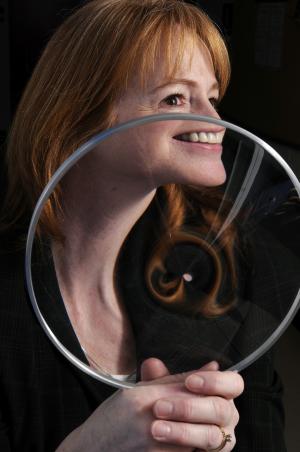In general relativity, mass can warp space and create gravitational fields that bend light - confirmed in by Arthur Eddington during a solar eclipse, when he saw that the light from stars that passed close to the sun was slightly bent, making them appear out of position.
Einstein realized that since astronomical objects can bend light it would also be possible to observe multiple images of a single source - a gravitational lens (and to some a gravitational mirage.) A foreground star could bend the light of another star sitting almost directly far beyond it, producing two images of the background star.
Evalyn Gates discusses the phenomenon of gravitational lensing. Gates is Assistant Director of the Kavli Institute for Cosmological Physics at the University of Chicago.
“Gravitational lensing magnifies things as well as making multiple images and distorting the shape of images, so you can actually use it as a magnifying glass,” says Gates, Assistant Director of the University’s Kavli Institute for Cosmological Physics.
Astronomers now use gravitational lensing to look for dark matter and the imprint of dark energy, two of the greatest modern scientific mysteries. Some theorists claim that the currently undefined dark energy, which seems to act in opposition to gravity, is the dominant force in the universe.
“We can’t see dark energy directly by any means, but we’re looking for how it has sculpted the matter distribution of the universe over the past few billion years, since it’s been the dominant factor, and also how it has affected the rate at which the Universe is expanding” Gates says.

Galaxies can warp space and time, distorting our view of distant objects, much the way this plexiglass lens distorts the appearance of Evalyn Gates, an astrophysicist at the University of Chicago. Astrophysicists use this effect, called gravitational lensing, in their studies of the cosmos. Credit: Dan Dry
Gravitational lensing is essentially the only method astronomers have for tracing out the web of dark matter that pervades the Universe, and determining how dark energy has impacted the evolution of this web. Like dark energy, dark matter is also invisible. Theorists want to be believe it accounts for most of the matter in the universe, though we don't know exactly what it is - whatever it turns out to be, it will differ significantly from normal matter (which is essentially composed of protons and neutrons) that dominates everyday life.
“What we’re made of is just about five percent of everything that’s in the universe,” Gates says.
In 1990s scientists wondered if a significant quantity of dark matter in the halo consisted of MACHOs (Massive Astrophysical Compact Halo Objects) – faint objects such as dim stars, Jupiter-sized planets or stellar-mass black holes that are all composed of normal matter but hard to see. Gates and her collaborators were among the researchers who used gravitational lensing to search for MACHOs within the halo of the Milky Way galaxy.
“We have seen MACHOs – but what we found is that they make up at most a small fraction of the galactic halo,” Gates said.
A look into galaxies past
Scientists also use galaxy clusters as gravitational lenses to probe 13 billion years back into the history of the universe. Gravitational lensing offers astrophysicists a tool comparable to magnetic resonance imaging and computing tomography, which have provided health professionals with unprecedented new views of the human body.
During the 20th century, quantum mechanics and general relativity radically altered scientists’ view of the universe, Gates says. Investigations of dark matter and dark energy may do likewise.
“Gravitational lensing is going to allow us to image the universe in ways that wouldn’t have been possible even 50 years ago,” she says.
Gates has a new book, "Einstein’s Telescope: The Hunt for Dark Matter and Dark Energy in the Universe", which seeks to explain how it works.






Comments